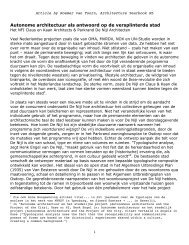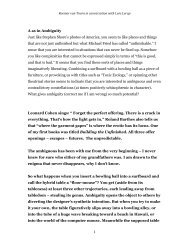Untitled
Untitled
Untitled
You also want an ePaper? Increase the reach of your titles
YUMPU automatically turns print PDFs into web optimized ePapers that Google loves.
68<br />
sands of kilometres away, for example<br />
in the offices of a foreign company or<br />
on the bridge of a large cargo ship at<br />
sea. The absence of reliable economic<br />
and market forecasts often obliges<br />
those operating in the Ports to assume<br />
direct responsibility for an intervention<br />
strategy.<br />
It happens so often that there are no<br />
scenarios from which to deduce the<br />
necessity of an action, which is instead<br />
completely intentional – in a word,<br />
political and argued without appealing<br />
to any deductive reasoning.<br />
Precisely because of these specific<br />
characteristics clearly distinguishing<br />
Ports from adjacent historical centres<br />
and at the same time revealing their<br />
common history, it is necessary to<br />
avoid the hypocrisy of a false promise<br />
of “integration” between Port and city.<br />
The relationship between Port and city<br />
in Italian coastal cities (frequently a<br />
source of bitter conflict and misunderstanding)<br />
must be dealt with above by<br />
all avoiding the opposing and mirrorlike<br />
tendencies of rigid separation (as<br />
in the past) and the two territories’<br />
mechanical integration (an attitude<br />
often hiding claims of hegemony by<br />
one over the other). The cohabitation<br />
between the two territories, and their<br />
reciprocal pairing, is only possible by<br />
starting from a clarification of their differences,<br />
aside from their similarities<br />
and “syntonies”, matured over decades<br />
of coexistence and communal use of<br />
infrastructure. The differences are<br />
physical and spatial, but also cultural<br />
and social. They root themselves in a<br />
different political and economic territorial<br />
management, but also in the inertia<br />
of two different imaginations.<br />
Calling for “integration” frequently<br />
means suggesting the quashing in<br />
whole or in part of the distinctive features<br />
of one of the two territories. This<br />
has happened for example with the<br />
large leisure/commercial interventions<br />
on the north American model,<br />
which have colonized, standardized<br />
and therefore killed off many “hybrid”<br />
urban areas in the Mediterranean city,<br />
as in Barcelona.<br />
The dock landscape and the city<br />
streets and squares can only become<br />
reacquainted without creating residual<br />
cracks by preserving or rather further<br />
clarifying their irreducibly different<br />
nature.<br />
In fact an alternative radical on the<br />
model of large United States and oriental<br />
Ports is involved, where only<br />
immense areas for the movement of<br />
containers and the shining quays for<br />
group tourism are alternated. They<br />
have the “Marinas”, fast food restaurants<br />
with figureheads, waiters with<br />
headbands, theme parks and large<br />
parking lots.<br />
The large Mediterranean port cities –<br />
Genoa, Naples, Athens, Salonika,<br />
Barcelona, Marseille, Alexandria – can<br />
and must avoid the overbearing monotony<br />
of this contrast, because they are<br />
still complex and composite places,<br />
where work mixes with resting places,<br />
cars with containers and big ships with<br />
historical buildings. They are still<br />
places where architecture can generate<br />
surprises, changes in scale and<br />
resonance between different and distant<br />
spaces.<br />
It is therefore an entire idea of the city,<br />
and not simply a problem of modernization,<br />
which lies in wait for those occupied<br />
in the transformation of the ports<br />
of southern European cities.<br />
Solid Sea<br />
(Multiplicity)<br />
Que se passe-t-il en Méditerranée?<br />
Le grand bassin d’eau qui pendant des années a été décrit<br />
comme étant «le berceau de la civilisation», le nœud de traditions<br />
millénaires et le point de rencontre de cultures diverses,<br />
est peut-être en train de changer de nature.<br />
La Méditerranée est en train de devenir une «Mer Solide». Un<br />
territoire sillonné par des itinéraires prédéterminés et des<br />
frontières insurmontables, subdivisé en bandes d’eau spécialisées<br />
et rigoureusement réglementées.<br />
Quelles que soient sa biographie et son identité, celui qui<br />
s’est aventuré dans les eaux de Solid Sea est contraint de les<br />
abandonner et d’accepter une identité embrigadée: touristes<br />
de croisière, militaires, pêcheurs, marins, immigrés clandestins,<br />
techniciens de sous-marins et de plates-formes.<br />
Identités rigides, spécialisées, qui se croisent tous les jours<br />
dans ses eaux sans communiquer et souvent même sans se<br />
regarder, condamnées dans leurs itinéraires préfixés. La<br />
Méditerranée est de nos jours un grand continent, située<br />
entre l’Europe, l’Asie mineure et l’Afrique. Un continent<br />
liquide, mais entaillé à différentes profondeurs par des couloirs<br />
impénétrables, subdivisé par de hautes barrières dans<br />
lesquelles alternent des enclos spécialisés et des grandes<br />
plaines déshabitées, entouré le long de ses rives par des<br />
entonnoirs d’entrée et de sortie qui répondent de plus en plus<br />
à des logiques d’exclusion et de séparation.<br />
1, 2, 3, 4. Odessa, courtesy Armin Linke<br />
Un nouveau Continent dont on ne<br />
connaît pas encore la géographie.<br />
Grâce à Solid Sea, Multiplicity souhaite<br />
promouvoir une recherche sur<br />
la nouvelle nature de la Méditerranée<br />
et dessiner un atlas actualisé<br />
concernant ses paysages et les turbulences<br />
qui les parcourent.<br />
What is going on in the Mediterranean?<br />
Could the very nature of this enormous basin of water, often<br />
referred to as «the cradle of civilization», source of ancient traditions<br />
and point of intersection for so many diverse cultures, be<br />
evolving into something entirely different?<br />
The Mediterranean is becoming a Solid Sea: A territory crisscrossed<br />
by predetermined itineraries and insurmountable borders,<br />
subdivided into specialized and strictly regulated strips of water.<br />
Regardless of one’s biography and identity, anyone entering the<br />
Solid Sea is compelled to abandon these and to accept an imposed<br />
identity: cruise ship tourist, soldier, fisherman, sailor, illegal immigrant,<br />
submarine or oil rig technician; rigid, specialized identities<br />
encountering each other every day in these waters, without communicating,<br />
and often not even looking at each other, condemned to<br />
follow their preordained route. Nowadays, the Mediterranean has<br />
become a great continent, lying between Europe, Asia Minor and<br />
Africa; a liquid continent, gashed at different depths by impenetrable<br />
corridors, subdivided by high barriers in which specialized<br />
enclosures and great deserted plains alternate, its shores surrounded<br />
by funnels for entry and exit, answering more and more to<br />
the logic of exclusion and separation.<br />
The geography of a whole new continent remains to be discovered<br />
there. Through Solid Sea, Multiplicity wishes to promote research<br />
into the Mediterranean’s changing nature and to design an updated<br />
atlas of its landscapes and turbulent waters.<br />
Solid Sea 02: Odessa / The World<br />
(Armin Linke)<br />
L’histoire paradoxale de deux grandes<br />
embarcations nous permet de<br />
comprendre la nouvelle nature de la<br />
Méditerranée. D’un côté le bateau<br />
ukrainien Odessa, qui est resté bloqué<br />
pendant des années dans le<br />
port de Naples avec une partie de<br />
son équipage, parce qu’il a été<br />
séquestré par le Tribunal. De l’autre,<br />
The World Residensea, un<br />
bateau de croisière de luxe: une<br />
ville flottante complètement autonome<br />
et en réseau avec le monde.<br />
De 1995 à 2002 pendant sept ans,<br />
l’Odessa n’a pas pu quitter le port<br />
de Naples, parce qu’il était sous<br />
séquestre à la suite de la banqueroute<br />
de la Compagnie Blasco<br />
(Back Sea Shipping Company),<br />
compagnie battant pavillon<br />
Soviétique. Le commandant<br />
Vladimir Lobanov et huit autres<br />
hommes de l’équipage ont continué<br />
à vivre à bord du bateau, sans car-<br />
69






